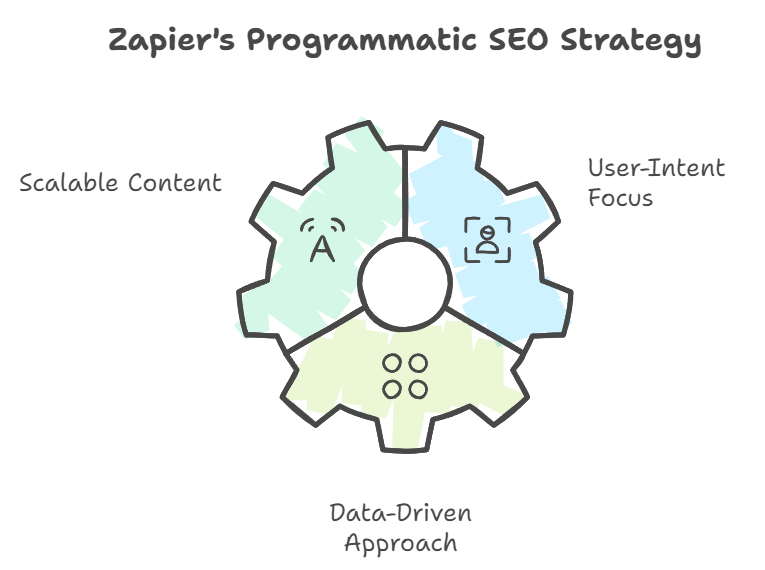Listen to this story
Overview of Zapier
Zapier functions as a web-based workflow automation platform. It empowers users to seamlessly integrate diverse applications, enabling the automation of repetitive tasks and streamlining business processes. A practical illustration of Zapier programmatic SEO would be the automatic generation of a new to-do list item within a designated application upon receiving an email with a predefined subject line.
Zapier programmatic SEO strategy – A brief overview
Zapier leverages programmatic SEO to achieve impressive organic growth. This advanced seo tactics and strategy involves creating many SEO-optimized web pages, targeting specific user needs. Here’s a breakdown of the key aspects:
- Scalable Content: By using data and pre-programmed rules, Zapier automatically generates content for each application they support. This allows them to target long-tail keywords related to specific app integrations.
- User-Intent Focus: Each programmatic page addresses a user’s specific need, like “connecting Google Sheets with [app name].” This ensures high relevance for search queries.
- Data-Driven Approach: Their database of supported apps fuels the content generation, allowing for in-depth pages dedicated to specific integrations.
In essence, Zapier utilizes programmatic SEO to create a massive library of highly targeted content, effectively capturing users with specific automation needs.
Segregation of traffic numbers behind Zapier’s programmatic SEO strategy
- Direct: 30.33% (5.1M)
- Organic Search: 49.73% (8.3M)
Why Zapier’s Traffic Distribution is Impressive:
- High Brand Awareness: A significant portion (30.33%) of Zapier’s traffic being direct indicates strong brand awareness. Users know Zapier’s value and remember their website address, suggesting a loyal user base and successful brand recognition efforts.
- Organic Search Domination: Nearly half (49.73%) of their traffic coming from organic search signifies effective Search Engine Optimization (SEO) strategies. Zapier likely ranks well for keywords related to workflow automation and app integrations, attracting a large audience organically.
This balanced traffic distribution shows Zapier’s success in both building brand awareness and attracting new users through search engines. It suggests they’ve established themselves as a thought leader in the automation space, while also effectively capturing users actively searching for solutions.
Source: Semrush
Detailed Zapier programmatic SEO strategy
2.6M monthly organic traffic
500K+ pages indexed on Google
Do more with {app} Integrations
- Do more with Google Sheets Integration
Create Integrations between {app1} and {app2} to automate workflow
- Create integrations between Descript and Notion to automate any workflow
- Create integrations between Google Calendar and Notion to automate any workflow
A Deep Dive into the Structure of Zapier Pages/Section
Zapier leverages programmatic SEO to achieve impressive organic growth. Let’s delve into their approach by examining the structure of their web pages. This analysis will specifically focus on App Pages and Integration Pages, highlighting the data points used for each.
App Pages
Zapier strategically targets integrations focused on transactional workflows within this area. Programmatically generated content found on ‘app profile pages’ functions similarly to landing pages, aiming to convert visitors seeking automation solutions for these specific integrations.
To illustrate this concept, let’s explore some example pages and analyze their estimated monthly organic traffic.
| Example page | Monthly organic traffic |
| Google Sheets integrations | 34k |
| Google Docs integrations | 42k |
| Gmail integrations | 60k |
Data Points
To ensure user satisfaction and optimize conversions, Zapier incorporates several key data points within its programmatically generated pages.
- CTA buttons
- List of apps to connect with
- Integration templates
- Tools integration details
- Supported triggers and actions of the app
- About the App
Integration Pages
Zapier programmatic SEO focuses on integrations facilitating transactional workflows by providing guides on connecting specific applications. Programmatically generated content under “app integration pages” functions similarly to landing pages, aiming to capture users seeking automation solutions for these precise integrations.
Let’s delve into some example pages within this category and analyze their estimated monthly organic traffic.
| Example page | Monthly organic traffic |
| How to connect Google Calendar + Notion | 800 |
| How to connect Steam + Twitter | 900 |
| How to connect Descript + Notion | 1.1k |
Data Points
Zapier strategically leverages specific data points to populate its programmatically generated pages, fostering a user-centric experience.
- A short description of the integration of the two apps
- CTA buttons to get started with
- Templates to get started with
- Description of How Zapier Works
- Supported triggers and action
- Related blogs section
Insights into Zapier’s Programmatic SEO Strategy
Effectiveness of Zapier’s Content Structure
Zapier’s App Pages and Integration Pages are highly organized, focusing on simplicity and relevance. By categorizing information logically, these pages optimize user experience and support SEO. The structured presentation of integrations targets specific long-tail keywords, enhancing search visibility while delivering a seamless user experience by answering direct user queries.
User-Centered Design and Programmatic SEO
Zapier’s programmatic SEO aligns with user-centered design principles by delivering tailored content that addresses users’ needs. Each integration page is crafted with the intent of solving problems for users searching for specific app connections, making their SEO strategy inherently focused on user satisfaction.
Comparing Zapier’s Approach to Other Companies
Compared to Yelp, which also uses programmatic SEO, Zapier focuses more on integration-related queries. Both companies target long-tail keywords and scale organic traffic through dynamic content generation, but Zapier excels in solving highly specific user needs with detailed integration pages, while Yelp relies more on location-based content.
Future of SEO for Zapier
As search algorithms evolve, Zapier may need to refine their content to maintain relevancy. The growing importance of semantic search and user behavior tracking means that Zapier will likely need to focus on deeper personalization, voice search optimization, and content updates to sustain their organic growth.
Build a programmatic SEO Strategy with uG
Witnessed the impressive organic growth Zapier achieved through Programmatic SEO (pSEO)? pSEO offers immense potential to scale your website traffic by targeting specific user needs with optimized content.
Partnering with a qualified pSEO agency like upGrowth can unlock this potential. upGrowth’s team of experts possesses the deep knowledge and experience to craft a customized pSEO strategy that propels your website to the top of search engine results pages, driving qualified leads and boosting your business growth.
Watch Now: How Zapier’s Programmatic SEO Strategy Drives Over 2 Million Monthly Organic Visits
Glossary of Key Terms
- Programmatic SEO: An automated, data-driven approach to SEO that involves generating large amounts of web pages targeting specific user queries and keywords.
- Long-tail keywords: Longer and more specific keyword phrases that target niche audiences with lower search volume but higher conversion potential.
- User intent: The underlying goal or purpose behind a user’s search query.
- Organic traffic: Website traffic that comes from unpaid search engine results pages (SERPs) rather than paid advertising.
- Direct traffic: Website traffic from users who directly type the URL into their browser or access it through bookmarks.
- App Pages: Dedicated pages on Zapier’s website that provide an overview of a specific application and its integration capabilities.
- Integration Pages: Pages that focus on the specific workflow between two integrated apps, outlining the triggers, actions, and benefits of connecting them.
- Data points: Specific pieces of information used to populate programmatic web pages, such as supported app features, integration templates, or user guides.
- Transactional workflows: Automated processes focused on completing specific tasks or transactions, like adding a lead to a CRM after they fill out a web form.
- CTA buttons (Call to action buttons): Website buttons designed to prompt an immediate response or encourage a specific action from the user, such as “Get Started Free” or “Learn More”.
Segregation of traffic numbers behind Zapier’s programmatic SEO strategy
- Direct: 30.33% (5.1M)
- Organic Search: 49.73% (8.3M)
Why Zapier’s Traffic Distribution is Impressive:
- High Brand Awareness: A significant portion (30.33%) of Zapier’s traffic being direct indicates strong brand awareness. Users know Zapier’s value and remember their website address, suggesting a loyal user base and successful brand recognition efforts.
- Organic Search Domination: Nearly half (49.73%) of their traffic coming from organic search signifies effective Search Engine Optimization (SEO) strategies. Zapier likely ranks well for keywords related to workflow automation and app integrations, attracting a large audience organically.
This balanced traffic distribution shows Zapier’s success in both building brand awareness and attracting new users through search engines. It suggests they’ve established themselves as a thought leader in the automation space, while also effectively capturing users actively searching for solutions.
Source: Semrush
Detailed Zapier programmatic SEO strategy
2.6M monthly organic traffic
500K+ pages indexed on Google
Do more with {app} Integrations
- Do more with Google Sheets Integration
Create Integrations between {app1} and {app2} to automate workflow
- Create integrations between Descript and Notion to automate any workflow
- Create integrations between Google Calendar and Notion to automate any workflow
A Deep Dive into the Structure of Zapier Pages/Section
Zapier leverages programmatic SEO to achieve impressive organic growth. Let’s delve into their approach by examining the structure of their web pages. This analysis will specifically focus on App Pages and Integration Pages, highlighting the data points used for each.
App Pages
Zapier strategically targets integrations focused on transactional workflows within this area. Programmatically generated content found on ‘app profile pages’ functions similarly to landing pages, aiming to convert visitors seeking automation solutions for these specific integrations.
To illustrate this concept, let’s explore some example pages and analyze their estimated monthly organic traffic.
| Example page | Monthly organic traffic |
| Google Sheets integrations | 34k |
| Google Docs integrations | 42k |
| Gmail integrations | 60k |
Data Points
To ensure user satisfaction and optimize conversions, Zapier incorporates several key data points within its programmatically generated pages.
- CTA buttons
- List of apps to connect with
- Integration templates
- Tools integration details
- Supported triggers and actions of the app
- About the App
Integration Pages
Zapier programmatic SEO focuses on integrations facilitating transactional workflows by providing guides on connecting specific applications. Programmatically generated content under “app integration pages” functions similarly to landing pages, aiming to capture users seeking automation solutions for these precise integrations.
Let’s delve into some example pages within this category and analyze their estimated monthly organic traffic.
| Example page | Monthly organic traffic |
| How to connect Google Calendar + Notion | 800 |
| How to connect Steam + Twitter | 900 |
| How to connect Descript + Notion | 1.1k |
Data Points
Zapier strategically leverages specific data points to populate its programmatically generated pages, fostering a user-centric experience.
- A short description of the integration of the two apps
- CTA buttons to get started with
- Templates to get started with
- Description of How Zapier Works
- Supported triggers and action
- Related blogs section
Insights into Zapier’s Programmatic SEO Strategy
Effectiveness of Zapier’s Content Structure
Zapier’s App Pages and Integration Pages are highly organized, focusing on simplicity and relevance. By categorizing information logically, these pages optimize user experience and support SEO. The structured presentation of integrations targets specific long-tail keywords, enhancing search visibility while delivering a seamless user experience by answering direct user queries.
User-Centered Design and Programmatic SEO
Zapier’s programmatic SEO aligns with user-centered design principles by delivering tailored content that addresses users’ needs. Each integration page is crafted with the intent of solving problems for users searching for specific app connections, making their SEO strategy inherently focused on user satisfaction.
Comparing Zapier’s Approach to Other Companies
Compared to Yelp, which also uses programmatic SEO, Zapier focuses more on integration-related queries. Both companies target long-tail keywords and scale organic traffic through dynamic content generation, but Zapier excels in solving highly specific user needs with detailed integration pages, while Yelp relies more on location-based content.
Future of SEO for Zapier
As search algorithms evolve, Zapier may need to refine their content to maintain relevancy. The growing importance of semantic search and user behavior tracking means that Zapier will likely need to focus on deeper personalization, voice search optimization, and content updates to sustain their organic growth.
Build a programmatic SEO Strategy with uG
Witnessed the impressive organic growth Zapier achieved through Programmatic SEO (pSEO)? pSEO offers immense potential to scale your website traffic by targeting specific user needs with optimized content.
Partnering with a qualified pSEO agency like upGrowth can unlock this potential. upGrowth’s team of experts possesses the deep knowledge and experience to craft a customized pSEO strategy that propels your website to the top of search engine results pages, driving qualified leads and boosting your business growth.
Watch Now: How Zapier’s Programmatic SEO Strategy Drives Over 2 Million Monthly Organic Visits
Glossary of Key Terms
- Programmatic SEO: An automated, data-driven approach to SEO that involves generating large amounts of web pages targeting specific user queries and keywords.
- Long-tail keywords: Longer and more specific keyword phrases that target niche audiences with lower search volume but higher conversion potential.
- User intent: The underlying goal or purpose behind a user’s search query.
- Organic traffic: Website traffic that comes from unpaid search engine results pages (SERPs) rather than paid advertising.
- Direct traffic: Website traffic from users who directly type the URL into their browser or access it through bookmarks.
- App Pages: Dedicated pages on Zapier’s website that provide an overview of a specific application and its integration capabilities.
- Integration Pages: Pages that focus on the specific workflow between two integrated apps, outlining the triggers, actions, and benefits of connecting them.
- Data points: Specific pieces of information used to populate programmatic web pages, such as supported app features, integration templates, or user guides.
- Transactional workflows: Automated processes focused on completing specific tasks or transactions, like adding a lead to a CRM after they fill out a web form.
- CTA buttons (Call to action buttons): Website buttons designed to prompt an immediate response or encourage a specific action from the user, such as “Get Started Free” or “Learn More”.






















